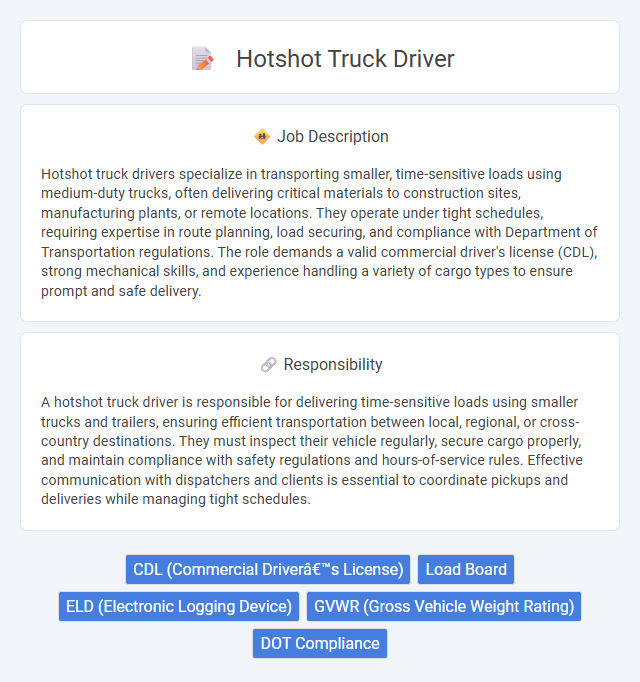
Hotshot truck drivers specialize in transporting smaller, time-sensitive loads using medium-duty trucks, often delivering critical materials to construction sites, manufacturing plants, or remote locations. They operate under tight schedules, requiring expertise in route planning, load securing, and compliance with Department of Transportation regulations. The role demands a valid commercial driver's license (CDL), strong mechanical skills, and experience handling a variety of cargo types to ensure prompt and safe delivery.
Hotshot truck driving may be suitable for individuals who prefer independent work and can handle long hours on the road, as the job often requires quick, time-sensitive deliveries. Those with strong organizational skills and the ability to maintain a reliable schedule might find this career fitting, though individuals who experience high stress or require frequent home time might struggle. Physical endurance and proficiency in vehicle maintenance could also increase the likelihood of success in this role.
Qualification
Hotshot truck drivers must have a valid commercial driver's license (CDL) with the appropriate class and endorsements, depending on the cargo type and state regulations. Experience with operating medium to heavy-duty trucks, knowledge of load securement standards, and familiarity with electronic logging devices (ELDs) are essential qualifications. Strong time management skills and a clean driving record enhance a driver's eligibility for high-paying hotshot delivery jobs.
Responsibility
A hotshot truck driver is responsible for delivering time-sensitive loads using smaller trucks and trailers, ensuring efficient transportation between local, regional, or cross-country destinations. They must inspect their vehicle regularly, secure cargo properly, and maintain compliance with safety regulations and hours-of-service rules. Effective communication with dispatchers and clients is essential to coordinate pickups and deliveries while managing tight schedules.
Benefit
Hotshot truck driver jobs likely offer flexible schedules and the possibility of higher earnings due to expedited deliveries and smaller loads. Drivers may experience increased independence and varied routes, which could enhance job satisfaction. Benefits might also include opportunities for skill development and building client relationships, potentially improving career growth in the transportation industry.
Challenge
Hotshot truck driver jobs likely involve navigating tight schedules and varying road conditions, demanding strong time management and adaptability skills. Drivers probably face the challenge of hauling smaller, urgent loads that require quick turnarounds, increasing pressure for prompt deliveries. The role may also entail maneuvering through urban or less accessible areas, adding complexity to the driving task.
Career Advancement
Hotshot truck driver careers offer significant potential for advancement through experience and skill development in expedited freight delivery. Drivers who demonstrate reliability and efficiency can progress to managing larger loads or transitioning into fleet management roles. Continuous training and obtaining specialized endorsements increase earning potential and open opportunities in logistics coordination and owner-operator positions.
Key Terms
CDL (Commercial Driver’s License)
Hotshot truck driver jobs require a valid Commercial Driver's License (CDL), which certifies the ability to operate heavy-duty vehicles and transport freight safely and legally. Obtaining a CDL involves passing rigorous knowledge and skills tests, including vehicle inspection, basic control, and on-road driving exams, ensuring drivers meet federal and state safety standards. Many hotshot drivers also pursue endorsements such as HAZMAT or doubles/triples to expand job opportunities and handle specialized cargo.
Load Board
Hotshot truck drivers rely heavily on load boards to quickly find short-haul freight opportunities, maximizing their route efficiency and income. Load boards like DAT, TruckStop, and 123Loadboard provide real-time access to available loads, enabling hotshot drivers to connect with shippers and brokers efficiently. Optimizing load board use reduces deadhead miles, ensuring hotshot drivers maintain high utilization rates and profitability.
ELD (Electronic Logging Device)
Hotshot truck drivers must comply with ELD (Electronic Logging Device) regulations to accurately record their hours of service, ensuring they meet federal safety standards. These devices automatically track driving time, reducing paperwork and minimizing the risk of violations or fines. Proper use of ELDs enhances route planning efficiency and helps maintain driver safety on tight schedules.
GVWR (Gross Vehicle Weight Rating)
Hotshot truck drivers operate medium-duty trucks with a GVWR typically ranging between 10,001 and 26,000 pounds, enabling them to transport smaller, time-sensitive loads efficiently. Understanding GVWR is crucial for compliance with federal weight regulations, ensuring safety and avoiding fines during hotshot deliveries. Properly managing GVWR allows hotshot drivers to maximize payload capacity while maintaining vehicle integrity and performance on the road.
DOT Compliance
Hotshot truck drivers must adhere strictly to DOT compliance regulations, including hours of service (HOS) limits, vehicle maintenance standards, and mandatory logbook or electronic logging device (ELD) usage. Ensuring compliance with weight restrictions, proper cargo securement, and driver qualification requirements is crucial to avoid fines and enhance road safety. Ongoing training and regular audits help hotshot truck drivers maintain full DOT compliance in fast-paced delivery environments.
 kuljobs.com
kuljobs.com